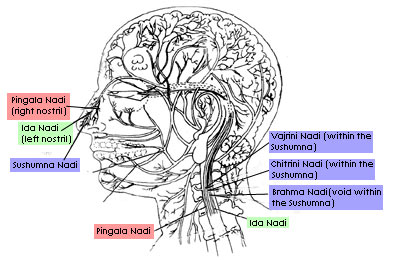 Swara Yoga is the effect of nasal breathing on our body and mind. When the right nostril breaths it is said that Pingala Nadi is active, left nostril is the sign for Ida Nadi and breathing through both nostrils means Shushumna Nadi is active. The different patterns and nature of breath denotes the active elements or the Pancha Mahabhutas i.e. Earth, Water, Air, Ether and Fire in our psychic body. In Swara Yoga practices flow of Nadi connects to the systematic pattern of phases of moon, sun and other planets. Elements are related with different planets in different nasal flow. The planets affect Earth`s gravitational field and electromagnetic field that alters human energy patterns in the psychic body of human being depending on the response. This can be experienced as the change on the flow of our breath. Swara Yoga identified this change as different elements. Swara Yoga provides effective tool in order to balance and harmonize the time and cycle of breath. The breath cycle mainly depends on the lunar phases or the Tithis.
Swara Yoga is the effect of nasal breathing on our body and mind. When the right nostril breaths it is said that Pingala Nadi is active, left nostril is the sign for Ida Nadi and breathing through both nostrils means Shushumna Nadi is active. The different patterns and nature of breath denotes the active elements or the Pancha Mahabhutas i.e. Earth, Water, Air, Ether and Fire in our psychic body. In Swara Yoga practices flow of Nadi connects to the systematic pattern of phases of moon, sun and other planets. Elements are related with different planets in different nasal flow. The planets affect Earth`s gravitational field and electromagnetic field that alters human energy patterns in the psychic body of human being depending on the response. This can be experienced as the change on the flow of our breath. Swara Yoga identified this change as different elements. Swara Yoga provides effective tool in order to balance and harmonize the time and cycle of breath. The breath cycle mainly depends on the lunar phases or the Tithis.
Tithi is the different phases of moon. The portion of moon is called kala, which undergoes waxing and waning from full moon or Purnima to the new moon or Amavasya. The fifteen days of waxing moon is the brighter phase and is called Shukla-Paksha while the darker phase of moon is called Krishna Paksha. In Indian Astrology, the calculation of Lunar phase is based on the half of the lunar cycle i.e. only on fifteen days and the first day after Amavasya or Purnima is called Pratipada.
In Swara cycle right nostril becomes active during Krishna Paksha on Tithes like Pratipada, Dwitiya, Tritiya, Saptami, Ashtami, Navami, Trayodashi, Chaturdashi, Amavasya. There after Ida and Pingala function alternately occurs in 1-2 hour cycle throughout the day until at sunset throughout the day until the sunset occurs and left nostril begins to function on the specified days. On fourth, sixth, tenth, twelfth days of dark fortnight (Krishna Paksha) the left nostril flows at sunrise and right nostril at sunset while during Shukla Paksha just the reverse takes place. During Shukla Paksha just reverse takes place. At sunrise of the first three days left nostril flows and during sunset right nostril is active. Same alternate manner goes on up to full moon.
According to Swara yoga cycle the flow of breath start twenty-four minutes before the actual sunrise and it continues for twelve minutes during the sunrise from the horizon and twenty-four minutes after the completion of sunrise and in the same way during sunset. If tithi is not the same during sunrise and sunset, one must avoid the flow of breath through the right nostril during sunrise and through the left nostril during moonrise. For rise and set of sun and moon and tithi, there are specific calculations of Swara Yoga cycle.




















